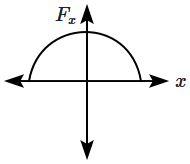Select Chapter Topics:
A particle undergoes SHM with an amplitude of \(10\) cm and a time period of \(4\) s. The average velocity of the particle during the course of its motion from its mean position to its extreme position is:
1. \(5\) cm/s
2. \(10\) cm/s
3. at least \(10\) cm/s
4. at most \(10\) cm/s
Subtopic: Simple Harmonic Motion |
From NCERT
Please attempt this question first.
Hints
Please attempt this question first.
Two SHMs of the form:
\(x=A+Asin\omega t\\ y=A-Asin\omega t\)
are superposed on a particle, along \(x\) and \(y\) directions. The resultant of these motions is:
\(x=A+Asin\omega t\\ y=A-Asin\omega t\)
are superposed on a particle, along \(x\) and \(y\) directions. The resultant of these motions is:
| 1. | circular motion |
| 2. | SHM along \(x\)-axis |
| 3. | SHM along \(y\)-axis |
| 4. | SHM, but along a direction other than \(x\) or \(y\)-axis |
Subtopic: Simple Harmonic Motion |
52%
From NCERT
Please attempt this question first.
Hints
Please attempt this question first.
Given below are two statements:
| Statement I: | If the acceleration of a particle is directed towards a fixed point, and proportional to the distance from that point – the motion is SHM. |
| Statement II: | During SHM, the kinetic energy of the particle oscillates at twice the frequency of the SHM. |
| 1. | Statement I is incorrect and Statement II is correct. |
| 2. | Both Statement I and Statement II are correct. |
| 3. | Both Statement I and Statement II are incorrect. |
| 4. | Statement I is correct and Statement II is incorrect. |
Subtopic: Energy of SHM |
From NCERT
Please attempt this question first.
Hints
Please attempt this question first.
A particle executes SHM along a straight line.
| Statement I: | A graph of its acceleration vs displacement (from mean position) is a straight line. |
| Statement II: | A graph of its velocity vs displacement (from mean position) is an ellipse. |
| 1. | Statement I is incorrect and Statement II is correct. |
| 2. | Both Statement I and Statement II are correct. |
| 3. | Both Statement I and Statement II are incorrect. |
| 4. | Statement I is correct and Statement II is incorrect. |
Subtopic: Simple Harmonic Motion |
70%
From NCERT
Please attempt this question first.
Hints
Please attempt this question first.
The effective spring constant in calculating the time period of SHM of the system of springs and the block is:

1. \((k_1+k_2)\)
2. \(|k_1-k_2|\)
3. \(\Big(\frac{1}{k_1}+\frac{1}{k_2}\Big)^{-1}\)
4. \(\Big|\frac{1}{k_1}-\frac{1}{k_2}\Big|^{-1}\)

1. \((k_1+k_2)\)
2. \(|k_1-k_2|\)
3. \(\Big(\frac{1}{k_1}+\frac{1}{k_2}\Big)^{-1}\)
4. \(\Big|\frac{1}{k_1}-\frac{1}{k_2}\Big|^{-1}\)
Subtopic: Spring mass system |
79%
From NCERT
Please attempt this question first.
Hints
Please attempt this question first.
Identify the function which represents a non-periodic motion?
| 1. | \(e^{-\omega t}\) | 2. | \(\text{sin}\omega t\) |
| 3. | \(\text{sin}\omega t+\text{cos}\omega t\) | 4. | \(\text{sin}(\omega t+\pi/4)\) |
Subtopic: Types of Motion |
81%
From NCERT
NEET - 2022
To view explanation, please take trial in the course.
NEET 2023 - Target Batch - Aryan Raj Singh
Hints
To view explanation, please take trial in the course.
NEET 2023 - Target Batch - Aryan Raj Singh
The restoring force of a spring, with a block attached to the free end of the spring, is represented by:
| 1. |  |
2. |  |
| 3. |  |
4. |  |
Subtopic: Spring mass system |
65%
From NCERT
NEET - 2022
To view explanation, please take trial in the course.
NEET 2023 - Target Batch - Aryan Raj Singh
Hints
To view explanation, please take trial in the course.
NEET 2023 - Target Batch - Aryan Raj Singh
Match List-I with List-II:
Choose the correct answer from the options given below:
| List-I (x-y graphs) |
List-II (Situations) |
||
| (a) |  |
(i) | Total mechanical energy is conserved |
| (b) |  |
(ii) | Bob of a pendulum is oscillating under negligible air friction |
| (c) |  |
(iii) | Restoring force of a spring |
| (d) |  |
(iv) | Bob of a pendulum is oscillating along with air friction |
Choose the correct answer from the options given below:
| (a) | (b) | (c) | (d) | |
| 1. | (iv) | (ii) | (iii) | (i) |
| 2. | (iv) | (iii) | (ii) | (i) |
| 3. | (i) | (iv) | (iii) | (ii) |
| 4. | (iii) | (ii) | (i) | (iv) |
Subtopic: Spring mass system |
83%
From NCERT
NEET - 2022
To view explanation, please take trial in the course.
NEET 2023 - Target Batch - Aryan Raj Singh
Hints
To view explanation, please take trial in the course.
NEET 2023 - Target Batch - Aryan Raj Singh
Two identical simple pendulums are compared, one \((A)\) located on the surface of the earth and the other \((B)\) – at a height \((h)\) above the earth's surface: \(h=\frac{R}{1000}.\)
Their time periods are related as:
1. \(T_A\Big(1+\frac{1}{1000}\Big)=T_B\)
2. \(T_B\Big(1+\frac{1}{1000}\Big)=T_A\)
3. \(T_A\Big(1+\frac{1}{2000}\Big)=T_B\)
4. \(T_B\Big(1+\frac{1}{2000}\Big)=T_A\)
Their time periods are related as:
1. \(T_A\Big(1+\frac{1}{1000}\Big)=T_B\)
2. \(T_B\Big(1+\frac{1}{1000}\Big)=T_A\)
3. \(T_A\Big(1+\frac{1}{2000}\Big)=T_B\)
4. \(T_B\Big(1+\frac{1}{2000}\Big)=T_A\)
Subtopic: Angular SHM |
58%
From NCERT
Please attempt this question first.
Hints
Please attempt this question first.
During simple harmonic motion of a body, the energy at the extreme position is:
| 1. | both kinetic and potential |
| 2. | is always zero |
| 3. | purely kinetic |
| 4. | purely potential |
Subtopic: Energy of SHM |
78%
From NCERT
NEET - 2022
To view explanation, please take trial in the course.
NEET 2023 - Target Batch - Aryan Raj Singh
Hints
To view explanation, please take trial in the course.
NEET 2023 - Target Batch - Aryan Raj Singh


